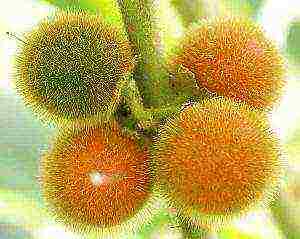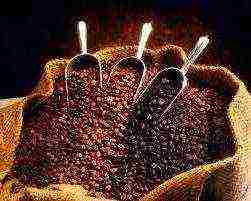Content
- 1 The best early varieties of black currant
- 2 The best mid-season blackcurrant varieties
- 3 The best late varieties of black currant
- 3.1 Variety Variety - mid-season black currant
- 3.2 Black pearl or Pearl - medium-early large-fruited
- 3.3 Selechenskaya-2 - early fruiting
- 3.4 Black boomer - early harvest from Kharkov
- 3.5 Big Ben - early variety, super productive
- 3.6 Pygmy - medium early
- 3.7 Raisin - early variety
- 3.8 Gulliver - early maturing
- 3.9 Summer resident - early ripening variety
- 3.10 Titania is a mid-season variety
- 3.11 Dobrynya is a mid-season variety
- 3.12 Bagheera - mid-season
- 3.13 Black currant is the sweetest - Green haze
- 3.14 Nina is an early sweet variety
- 3.15 Bagheera is a mid-season sweet variety
- 3.16 Constellation - early ripening variety
- 3.17 Maria Kievskaya
- 3.18 Nestor Kozin
- 3.19 Exotic
- 3.20 Perun
- 3.21 Dubrovskaya
- 3.22 Crane
- 3.23 Venus
- 3.24 Bummer - late-ripening variety
- 3.25 Arcadia
- 3.26 Vologda
- 3.27 Altai Late
- 3.28 Tatyana's Day
- 4 The best varieties of black currant for central Russia
- 5 Choosing varieties for central Russia
- 6 Currant for Siberia
- 7 What are the largest-fruited varieties?
- 8 The most resistant varieties
- 9 Gourmets also have plenty to choose from
- 10 What's new for residents of the Moscow region?
- 11 Conclusion
Review of the best varieties of black currant - according to gardeners' reviews
Black currant is a berry shrub that is grown everywhere in Russia. Local semi-wild forms are well adapted, but disappointing in yield, size and flavor of berries. Fruitful breeding work presented gardeners with 224 varieties (from the State Register of 2018). In terms of the number of varieties, black currant takes 2nd place, second only to the apple tree.
Blackcurrant varieties are divided into 2 large groups: amateur and industrial... The first group is distinguished by the dessert flavor of berries and is suitable for eating from a bush throughout the season. The second group is characterized by amicable ripening and suitability for mechanized harvesting (thick skin, dry separation, resistance to shedding). Industrial varieties can also be grown in a summer cottage, you just need to understand the purpose for which this or that variety was bred, and not scold the breeder for sourness.
Black currants are sensitive to growing conditions. One variety shows itself in different ways in different regions. To get an exact match with the variety description, you need to purchase varieties bred in your region. Bushes begin to bear fruit from the second year - such early maturity simplifies the process of selecting varieties for your site.
The rating of the best black currant varieties includes only the most popular varieties that have shown themselves well in terms of a set of parameters in different growing regions. In addition to those included in our rating, such varieties of black currants as Bagheera, Pygmy, Yadrenaya, Veloy, Raisin, Slastena, Exotica, Green haze, which have received many positive reviews and recommendations from gardeners, are of interest.
Rating of the best varieties of black currant
| The best early varieties of black currant | 1 | Litvinovskaya | 9.8 / 10 | 230 |
| 2 | Gift of Smolyaninova | 9.8 / 10 | 230 | |
| 3 | Selechenskaya 2 | 9.8 / 10 | 490 | |
| 4 | Summer resident | 9.7 / 10 | 350 | |
| The best mid-season blackcurrant varieties | 1 | Dobrynya | 9.7 / 10 | 250 |
| The best late varieties of black currant | 1 | Lazy person | 9.5 / 10 | 200 |
The best early varieties of black currant
|
Litvinovskaya 230 (annual seedling in a bag with wet peat) Medium early variety for universal use. The bush is powerful and tall. Shoots are straight, forming a compact, neat crown. Brushes of medium length and density, slightly curved.The berries are round, black, shiny, on a thin stalk, with a dry separation. The average weight of berries is 2.9 - 4.5 g, and with proper care, it exceeds 5 g. Due to the peculiarity of the location of the berries, it is inconvenient to pluck a whole brush. Small seeds and thin skins make the variety ideal for all types of processing. At the same time, the skin is strong enough, and the berries tolerate transportation well. Taste qualities are estimated at 5 points, there is a delicate aroma. Leaves with a pronounced currant aroma and are used in the preparation of tea and as a spice in conservation. The average productivity of one plant is 1.4 - 2.5 kg. Shows excellent winter hardiness and frost resistance, susceptible to high temperatures and poor drought tolerance. Not affected by fungal diseases, rarely colonized by kidney mites. This variety of black currant has shown itself well in the Moscow region. Main pluses:
Minuses:
|
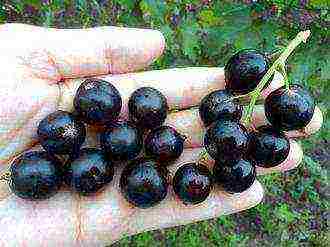 9.8 / 10 Rating Reviews Dessert berry for eating from a bush, tender pulp with a light aroma, for children as a delicacy.
|
|
Gift of Smolyaninova 230 (annual seedling in a bag with wet peat) A versatile early ripening variety of black currant. Bushes with medium vigor, with a dense, slightly spreading crown. The brushes are short, loose. The berry is large (3 - 5 g), round, glossy black, on a thin stalk. Taste qualities are estimated at 4.9 points. The yield of one plant is 2 - 3 kg. It is characterized by high self-fertility, which reduces dependence on pollinating insects and pollinating varieties. At the same time, with the presence of different varieties on the site, an increase in yield is noted. Differs in high resistance to fungal diseases and kidney mites. Recommended for cultivation in the Central region, but it manifests itself well throughout the Middle lane. Main pluses:
Minuses:
|
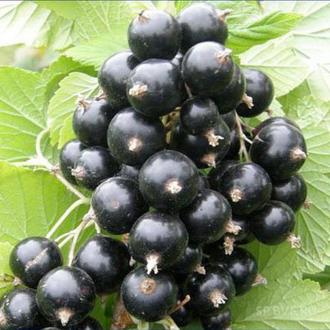 9.8 / 10 Rating Reviews The best variety of black currant for the Moscow region, I think. The berries are sweet, with a thin skin. The bunch ripens evenly, but you need to let the berries ripen completely and collect sugars.
|
|
Selechenskaya 2 490 (2-year-old seedling in a container) An early ripe dessert variety of black currant, which is also suitable for an industrial scale. The bush is upright, powerful, reaches 1.5 - 2 m. The brushes are long, loose. Berries are glossy, black, round, weighing from 2.5 - 3 to 5.5 g, with a thin and strong skin. The taste is estimated at 4.9 - 5 points, with a slight sourness and delicate aroma. Ripening amicably, ripe berries are resistant to shedding. The productivity of young bushes is 2 - 3 kg, adult plants with competent agricultural technology give up to 5 - 8 kg. The variety is resistant to powdery mildew, is slightly affected by anthracnose and is rarely colonized by a kidney mite (one preventive treatment is enough). It adapts well in different climatic zones, high winter hardiness and drought resistance. In hot weather and with interruptions in watering, the berries do not crack. The best results were obtained when grown in the Leningrad region, Moscow region, Western Siberia, Altai, Transbaikalia and Yakutia. Main pluses:
Minuses:
|
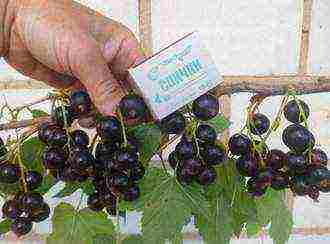 9.8 / 10 Rating Reviews I recommend everyone to have this variety of black currant on the site. I evaluate all new varieties by it, in comparison.
|
|
Summer resident 350 (2 year old seedling in a container) An early maturing variety for universal use. The bush is undersized, with a rounded spreading crown, the lower shoots can lie on the ground. The berries are blue-black, matte, medium-sized (2.2 - 4 g), slightly oval, with a thin skin, delicately sweet taste, with a strong aroma. The average yield of an adult plant is 1.4 - 1.5 kg.In summer cottages, the productivity of the variety is noted at the level of 4 - 5 kg. The uneven ripening of berries can also be assessed as a positive feature, since it prolongs the period of use of fresh berries. It is not affected by powdery mildew and kidney mites. It reacts poorly to drought; in the absence of watering, a discharge of unripe berries is observed. Flowering bushes under the threat of frost require protection. The variety has proven itself well in the Moscow and Leningrad regions. Main pluses:
Minuses:
|
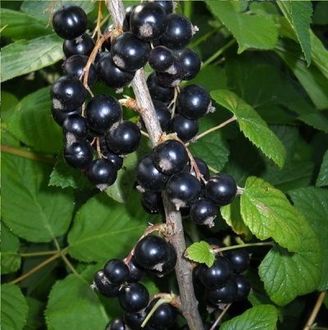 9.7 / 10 Rating Reviews The bush is undersized, but props are needed, as the lower branches bend towards the ground. Does not get sick, well suited for fresh consumption.
|
The best mid-season blackcurrant varieties
|
Dobrynya 250 (annual seedling in a bag with wet peat) A mid-season variety of an intensive type, that is, it requires high agricultural technology. Bushes of medium growth, with a compact crown, props are needed during the fruiting period, since the lower branches can lie on the ground under the weight of the berries. It gives low growth and is recommended for tight plantings. The brushes are medium in size, loose. There are fewer berries at the base of the cluster, which makes it easier to harvest with whole clusters. The berries are slightly oval, black with shine, very large (individual specimens weighing more than 6 g), with a dry separation and dense skin. Berries are sweet and sour, with a pronounced aroma, transportable. The yield during the variety testing was 1.6 - 2.4 kg / bush. It is characterized by high winter hardiness and low damage from recurrent frosts. Good immunity to powdery mildew, medium - to kidney mites. This variety of black currant is recommended for Western Siberia and the Central region. Main pluses:
Minuses:
|
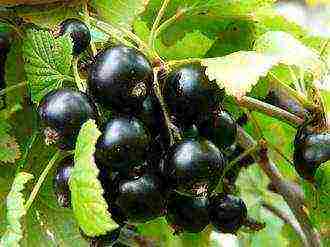 9.7 / 10 Rating Reviews The best variety of black currant for Siberia. The fruits are large. Eat such a berry only from a bush, it's a pity to let it go for processing.
|
The best late varieties of black currant
|
Lazy person 200 (annual seedling in a bag with wet peat) Late ripening black currant for an amateur garden. Bushes are tall, powerful; with a dense, spreading crown. Clusters up to 8 cm long, on a long petiole. Berries are black with a brown tint, rounded, with an average weight of 2.1 - 2.5 g, with a delicate skin, dry separation, very aromatic, sweet with a refreshing sourness. A feature of the variety is the size heterogeneity of the berries. Productivity 0.9 - 1.2 kg / bush. Self-pollination of the variety is average, therefore, for a high yield, planting of pollinating varieties is recommended. Possesses high winter hardiness, anthracnose and terry resistance. Kidney mites are moderately affected. Susceptible to powdery mildew, therefore requires preventive treatments, does not tolerate shading and waterlogging. The variety is suitable for extending the fresh berry season. It has shown itself well in the Moscow region and the Volga region, it is recommended for the entire Middle zone. Main pluses:
Minuses:
|
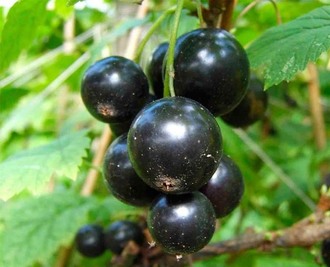 9.5 / 10 Rating Reviews This black currant winters well, the berries are large and sweet when allowed to ripen. Ripens 2 weeks later than my other varieties.
|
When buying black currant seedlings, you need to pay special attention to the condition of the root system and kidneys. Well-branched healthy roots without outgrowths and thickenings will guarantee high survival rate.Even if the kidneys look healthy, decontamination is recommended so as not to infect the garden with a dangerous pest - kidney mites.
Black currant loves the sun, but in arid regions, young seedlings simply burn out in one season, and if they survive until autumn, then being weakened they freeze out. Planting is best done in shaded areas at midday, mulching, and watering regularly.
Have a nice harvest!
Attention! The reliability of the information and results of the ratings is subjective and does not constitute advertising.
Currant is a tasty and very healthy berry, unpretentious in cultivation and distribution. It is not difficult to cultivate currants, and in order to collect stable good yields on time, you need to choose the right variety that suits you.
Let's look at the possibilities of modern breeding and get acquainted with the varieties that are offered by breeding institutes. Here are the characteristics of various varieties of currants with photos and descriptions.
Black currant varieties with large berries
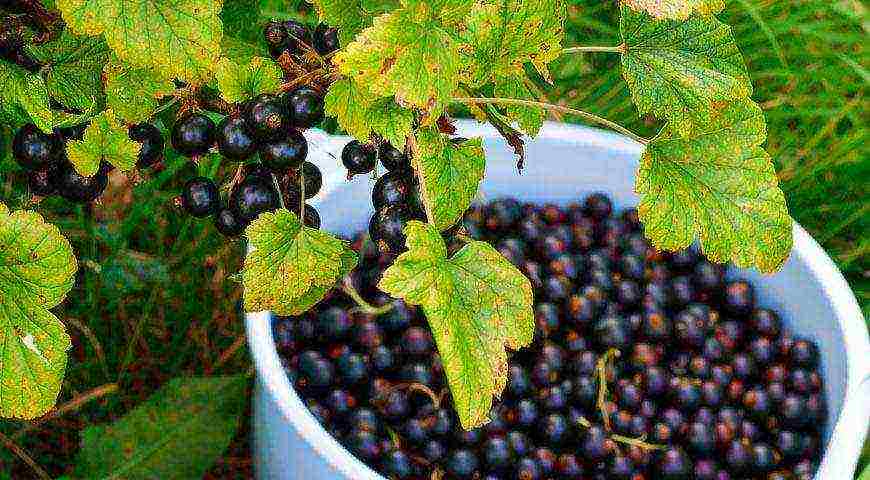
Large varieties of currants attract high yields. Often the berries of these varieties form clusters similar to grapes. In return, they require high-quality cultivation, fertilization, watering, attention and care.
Most large-fruited varieties do not form large enough berries without watering, give reduced yields.
Also, due to the large size, the question arises about the safety of the whole berry. The strength and density of the peel must withstand the pressure of the juice when pouring the berries, as well as ensure keeping quality during transportation and storage.
For the cultivation of large-fruited bushes, agricultural technology is important. The soil under the bushes for the season significantly consumes the supply of nutrients for growing crops.
Also, it is important for large-fruited varieties - that the growth of pagon branches does not lag behind fruiting.
In order for the yields to be stable and annual, timely replacement of the branches of the bush is necessary. Currants bear fruit well on those shoots, the annual growth of which is at least 25 cm. Therefore, branches with a weak growth, the age of which exceeds 4-5 years, must be cut off.
The selection of large-fruited varieties should also take into account the time of maturation of the variety and harvest. Early - bear fruit at the beginning of July. Medium - after the middle of the month, late - in August.
And now, according to the list of varieties and their description, let's see which variety of black currant is the largest and sweetest?
On a note: all varieties described below are winter hardy. They tolerate frosts and prolonged cold weather well, cope with spring return frosts. Therefore, we will not further indicate the characteristics of winter hardiness for each variety separately.
Variety Variety - mid-season black currant
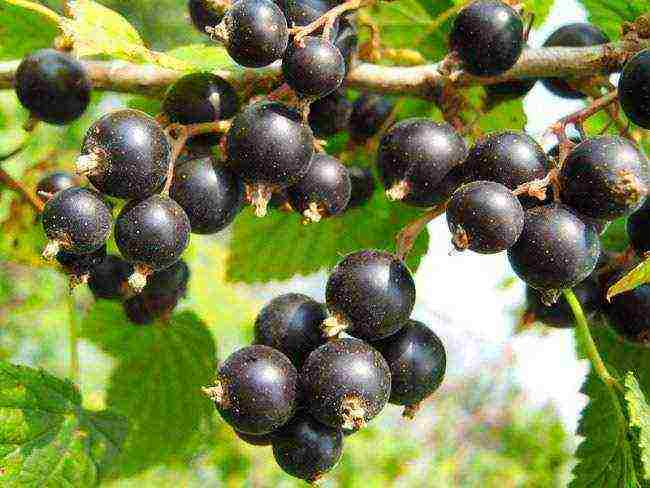
A variety with large berries weighing up to 6 g. Berries are collected in clusters of 8-10 pieces. Thus, the weight of one brush can reach 60 g. And 20 good brushes can make up more than 1 kilogram of the crop.
The yield indicator is 6 kg of berries per bush per year. Their taste is sweet with sourness (they contain 9% sugar and only 3.5% acid - for comparison, in sweet varieties of sugars there is almost the same amount - from 10%), the peel is dense. Bushes grow up to 1.5 m in height.
Yadrenaya is a well-deserved record holder among varieties of large black currants. She needs annual rejuvenation. The branches are severely depleted during the fruiting season, therefore, they require cutting and replacement with new pagons.
What you need to know the disadvantages: the different size of the berries, their size may vary. Another drawback is that the bush is aging and requires replacement after a few years. The number of years of good fruiting depends on the quality of the care. With good soil and sufficient watering, the bushes can retain their yield for 6-7 years.
Black pearl or Pearl - medium-early large-fruited
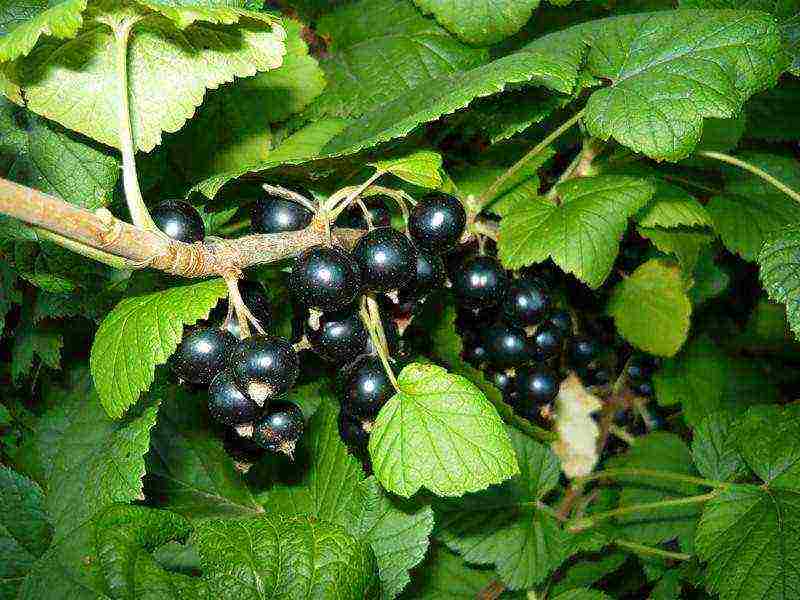
Another record holder who received the title of "Masterpiece of Russian selection". Bred to VNIIS Michurin. Fruits in berries weighing up to 6 g.The taste is sweet with a slight sourness (contains 9.5% sugars). Yields up to 5 kg of berries from each bush.
The name of the variety is associated with the characteristic "pearl" luster. The dense rind ensures keeping quality and the so-called "dry" pull-off. Berries of the Black Pearl are perfectly transported.
The shrub of the variety is distinguished by vertically growing branches, the height of the bushes is up to 1.3 m.Without snow cover, without damage to the future harvest, it tolerates frosts down to -42 ° C. At the same time, it tolerates heat and sun up to +40 without shading.
The advantages of the variety are a good harvest in any year, resistance to mites.
The disadvantage of the variety is that the variety tastes sour, not always resistant to pests, fungal diseases.
Selechenskaya-2 - early fruiting
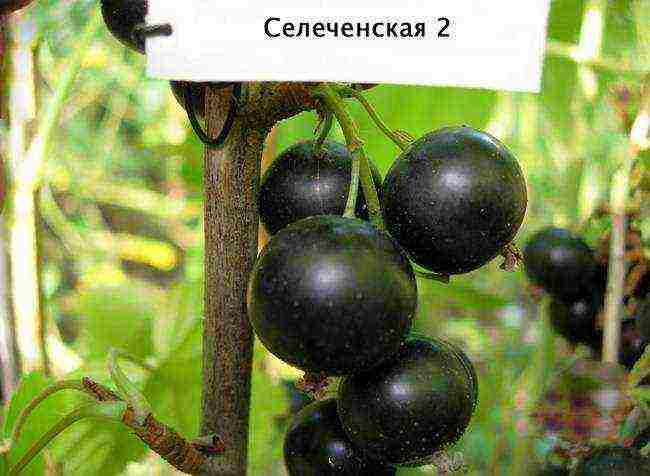
The weight of the berries reaches a maximum of 6 g, they have a sweet and sour taste (7% sugar in the berries) and a dense peel (provides the so-called dry separation and keeping quality). Strong aroma.
There are 10-15 berries per cluster. Very tall dense bushes - up to 2 m, yield up to 5 kg of berries per fruiting season.
Advantages: resistance to both cold and heat and lack of moisture. Not affected by dew.
Disadvantages - the variety requires good care, fertilized soil, and sufficient nutrients. Poorly resistant to pests.
Black Boomer - early harvest from Kharkov
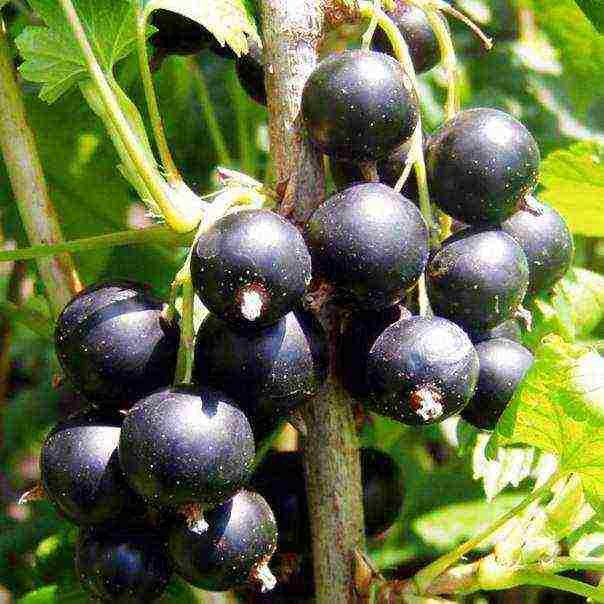
The weight of the berries is large, up to 7 g. Collected in a bunch resembling grapes, up to 10 berries in each bunch. The bush is upright and compact, yields up to 4 kg of berry harvest per year.
Advantages: uniformity of ripening and uniformity of berries. Do not crumble after ripening. Stable fruiting every year. Resistance to fungal and other diseases.
Disadvantages: with heavy rains and a lot of moisture, the berries may crack. Pick-off is not always dry.
Big Ben - early variety, super yielding
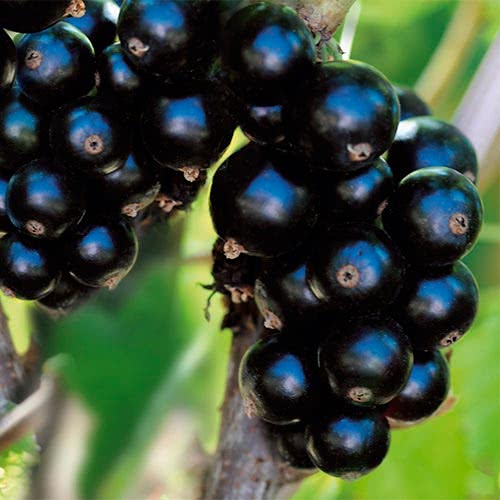
Another variety, the name of which speaks for itself.
Average weight of berries - up to 4 g. The yield of one bush can reach 10 kg (with good care). The taste is sweet and slightly sour, with sweetness prevailing over acid.
Advantages: after ripening, the berries do not crumble. Resistant to frost and powdery mildew.
Disadvantages: exactingness to care - obligatory pruning, fertilization, watering.
Pygmy - medium early
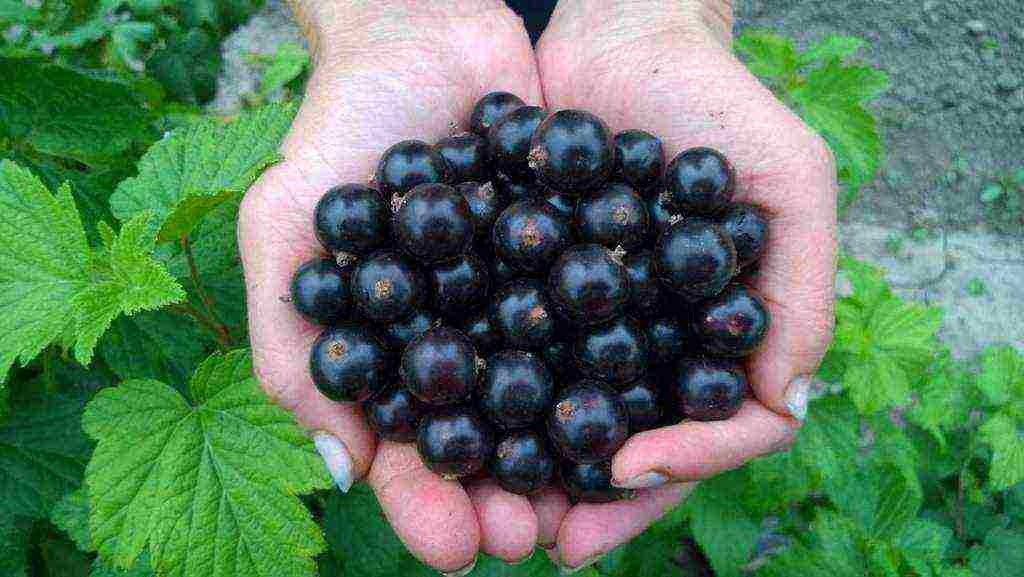
Berries weight up to 8 g, up to 10 pieces per brush. Even over time, with the aging of the branches, the berries retain their large size. The taste is very sweet, it contains 9.5% sugars. The bushes grow up to 2 m high, but the branches are compact, so they do not take up much space.
The variety gives up to 7 kg of berries per season from a bush.
Advantages: the variety is capable of self-pollination and high yields. The bushes are resistant to powdery mildew. Their winter hardiness is determined by thick stems and a large supply of nutrients, it is -35 ° C.
Disadvantages: low resistance to tick and septoria infection.
Raisin - early variety
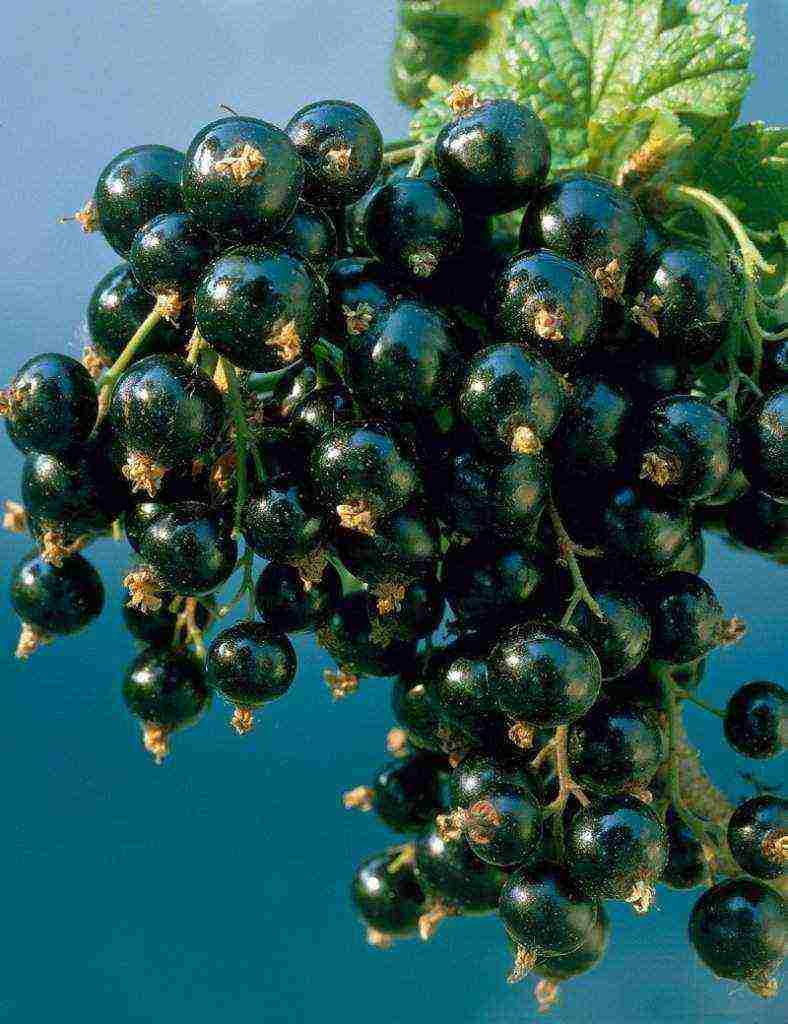
The name of the bush is due to the fact that after ripening the berries do not crumble from the bush, remain on the branches, wither and turn into a kind of raisins. This is the exclusive properties of the raisin variety.
Berries differ in average weight - up to 4 g, in a brush there can be 10-12 sweet berries, in which up to 9% of sugars. Productivity - average, 3.5 kg per bush. The direction of growth of pagons is upward. Thanks to this feature, bushes can be planted denser than usual.
Ripening period - early. The taste is sweet.
Advantages: winter hardiness and resistance to heat, fungal infections, ticks.
Disadvantages: poor rooting, bushes of this variety are more difficult to propagate by cuttings, unlike most traditional black currant varieties.
Gulliver - early maturing
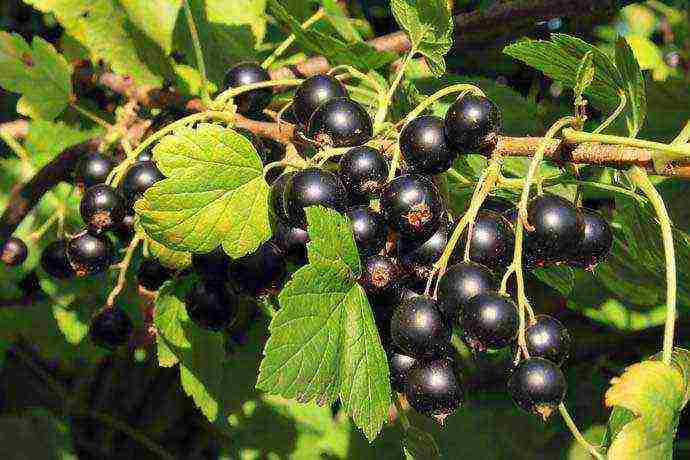
The weight of Gulliver berries reaches 5 g. Considering that there can be 20 berries in the bunch of this variety, the weight of the bunch turns out to be weighty - up to 100 g. The taste of berries is rich, with a well-felt sourness. Sugar in berries 6.5%. The bush is tall and leafy, yields up to 2 kg per year.
Advantages: the variety is resistant to very severe cold and long spring frosts.Resistant to kidney mites.
Disadvantages: picky about light, bears fruit well in open sunny places when watering. Lack of water is reflected in a decrease in the amount of crops.
Summer resident - early ripening variety
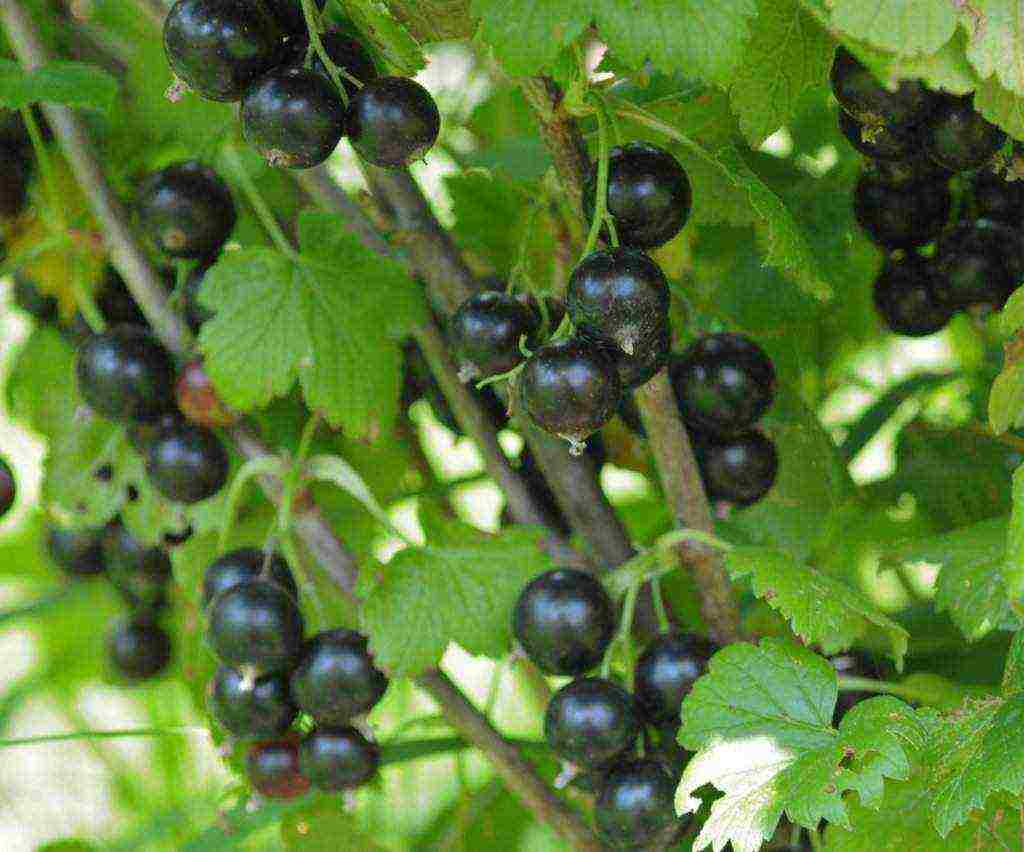
The size of the berries is large enough - up to 5g, very sweet, contain 9.3% sugars. The total yield of the bush is average, up to 1.5 kg of berries per year. The bush is undersized, withstands frosts down to -35 ° C.
Advantages: high self-fertility (more than 70%, in most varieties - about 50%, and this is considered a good indicator).
Disadvantages: due to the short stature, the branches during the ripening of the crop can bend low to the ground and touch the ground. Therefore, props and timely harvesting are needed. Berries not picked on time quickly crumble. The fruits ripen unevenly.
Titania is a mid-season variety
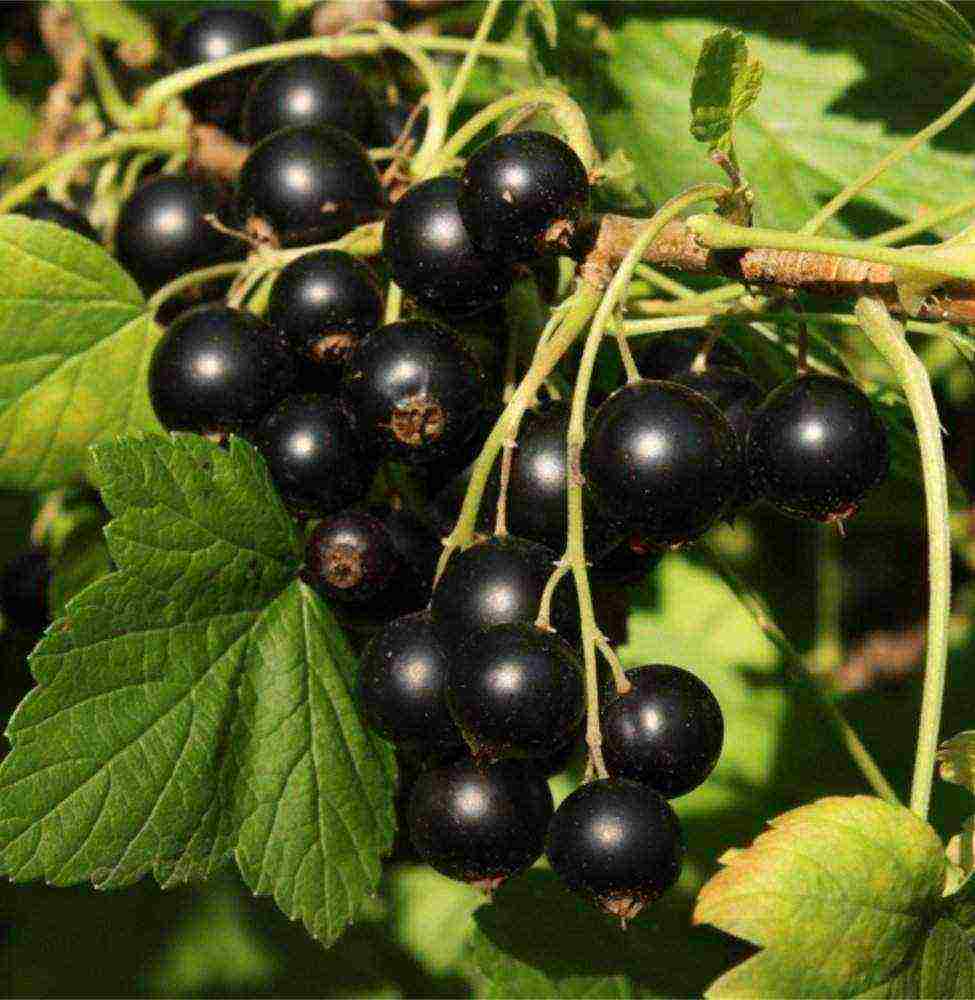
Despite the name, the variety bears fruit with medium-sized berries. The weight of each berry does not exceed 4 g. However, with a large number of berries in the bunch (up to 25 pieces), the yield of the variety is quite high - 4 kg per bush per fruiting season.
The taste is traditional sweet and sour (there are not so many sugars, only 6.5%). Another feature of the variety is that the berries ripen in batches within 3 weeks. Which is convenient for home assembly and inconvenient for a mechanized one.
The advantages of the variety: resistance to cold climates and diseases, tolerates frosts down to -24 ° C without loss of yield, does not choke when harvested.
Disadvantage: the variety requires good care - fertilizers, watering, pruning, timely replacement of bushes.
Dobrynya is a mid-season variety
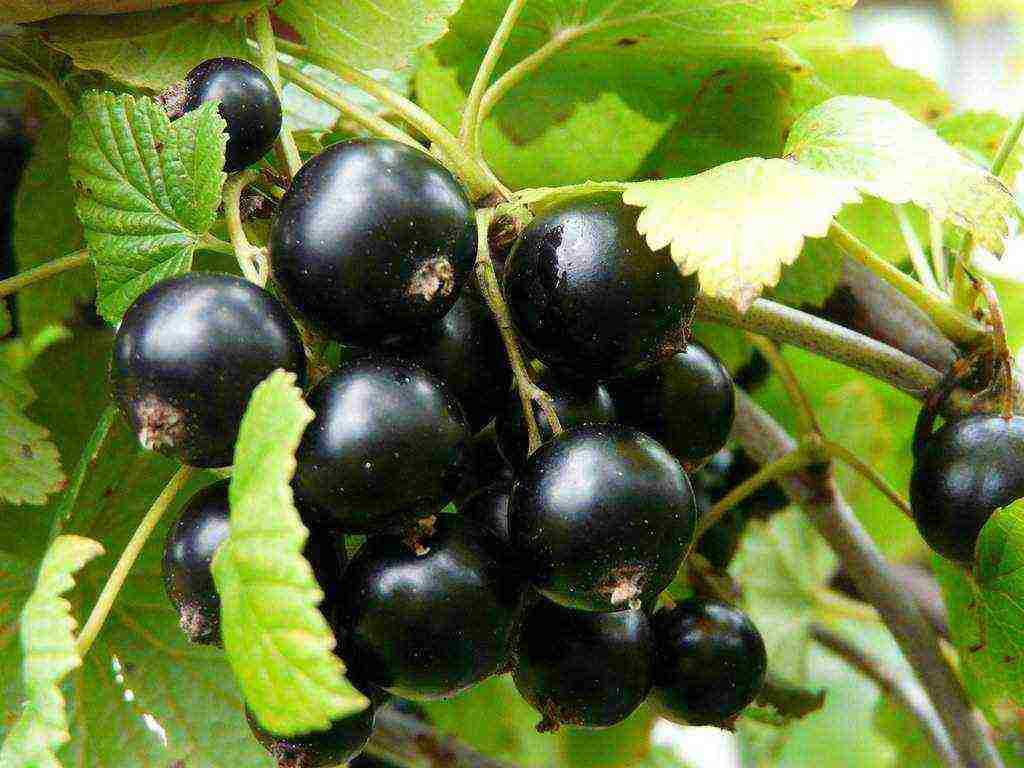
A fairly large variety with a weight of each berry up to 7 g. Each cluster contains 8-10 berries. Up to 3 kg of harvest is harvested from each bush. Sweet and sour taste with an average sugar content of 7%, dense peel provides transportability and shelf life.
The height of the bush is up to 1.7 m with a compact, non-spreading crown. This makes the variety popular for summer cottages in small, confined areas.
Advantages: high winter hardiness, not afraid of long and severe frosts, resistance to adverse factors - drought, powdery mildew, without loss of yield.
Disadvantages: different sizes of berries, exactingness to care, low resistance to fungal diseases.
Bagheera - mid-season
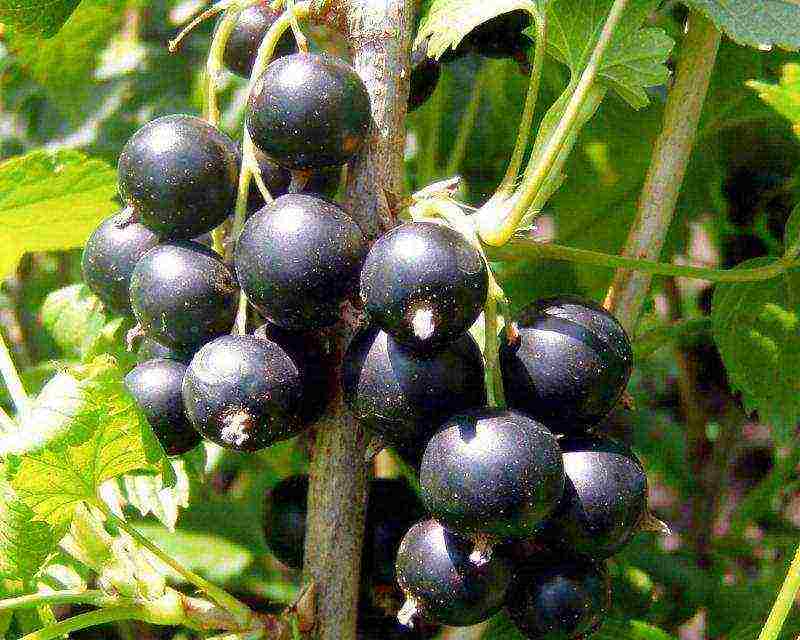
Berries weighing up to 7 g, 7 pieces per brush. Very sweet, contains 12% sugar. The bushes are tall, reaching 2 m. With good care, 4.5 kg of berries are harvested from each bush.
Advantages: the variety is equally adapted to cold and heat, frost and drought, suitable for growing in a harsh continental climate. And also resistant to pests.
Sweet black currant varieties
Sweet currant varieties contain more than 10% sugars. However, they also contain vitamin C (ascorbic acid). The amount of vitamin C determines the sourness of the variety - whether it will feel strong, or weak, barely noticeable.
As a rule, sweet blackcurrant varieties have almost no sour taste. Therefore, they represent a tasty prey for wasps. For such varieties to ripen, natural protection is needed - a dense peel on the berry. Otherwise, the crop will be stably destroyed by wasps.
The sweetest varieties of black currants contain more than 12% sugars. Their taste resembles grapes, and the sweetness is provided by the name of the varieties - dessert. For information on the characteristics of black currants (different varieties: super large, sweet and fruitful) - see below on the description and photo.
Black currant is the sweetest - Green haze
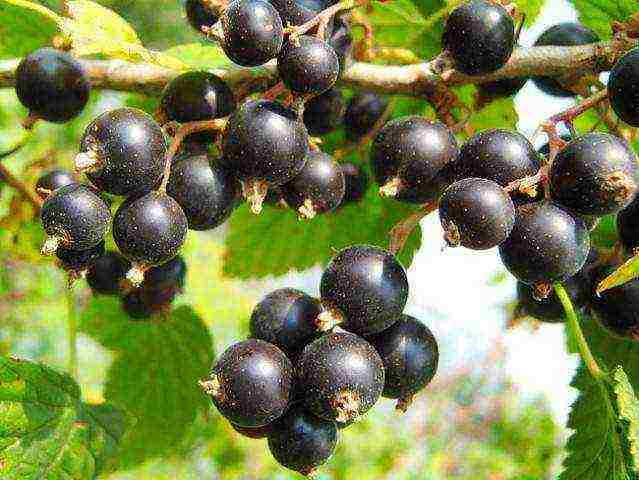
A short bush, the berries of which contain up to 13% sugars. Ascorbic acid in them - 200 mg per 100 g.
The size of the berries is medium, up to 2.5 g. High yield of the bush - up to 7 kg of berries per season.
Disadvantage: poorly resistant to ticks.
Nina is an early sweet variety
The variety, in the berries of which up to 11% sugars and up to 270 mg 100 g of vitamin C. Berries up to 4 g, bushes stably bear fruit up to 4 kg over the summer. They are demanding for watering, in which they grow berries twice as large - up to 8 g each. Moreover, all berries are the same size. Easily propagated by cuttings.
Disadvantage: poor transport stability.
Bagheera is a mid-season sweet variety
A variety in which up to 12% sugar and up to 190 mg 100 g of ascorbic acid. The characteristics of the variety are given above, we will repeat them. Berries weighing up to 7, bush yield up to 4.5 kg. Ripen at once, suitable for farming.
Disadvantage: low resistance to dew and pests.
Constellation - early ripening variety
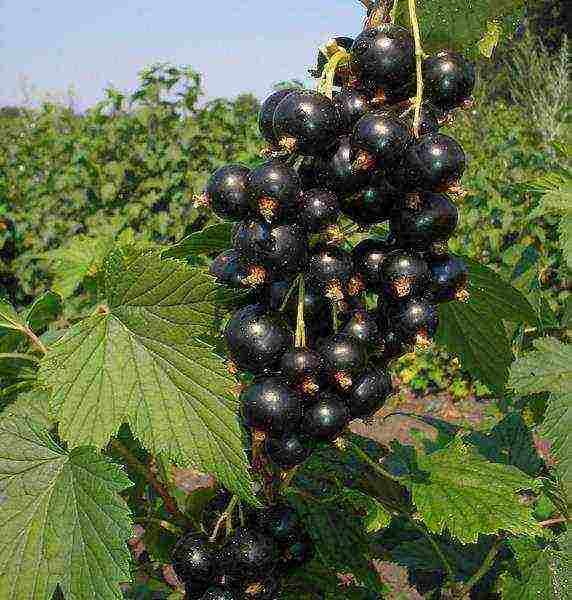
The weight of the berries is small, reaching 1.5-2 g, the sweet taste is provided by 11% of sugar in the pulp. The total yield is also average - about 2.5-3 kg per bush.
The bushes are medium-sized and slightly spreading. Branches are of medium thickness.
Advantages: the ability to bear fruit even without watering. Bushes give 3 kg of berries, even in the "worst" for growing, dry seasons. Also important: self-fertility, winter hardiness, resistance to pests and diseases.
Disadvantages: poor resistance to kidney mites.
Early varieties of black currant
Ripe berries are yielded in early July, and in the southern regions - in the middle and second half of June. For early varieties, spring frost resistance is important. They wake up early (at least April), bloom (usually in May) and more than other medium and late varieties suffer from recurrent frosts or spring cold snaps.
The early maturing varieties Dachnitsa and Selechinskaya were described above. Here are the characteristics of other varieties.
Maria Kievskaya
Berries up to 4 g, sweet and sour. Used for processing and freezing. Medium-sized spreading bushes.
Advantages: resistance to one of the common diseases of shrubs - rust, resistance to powdery mildew.
Nestor Kozin
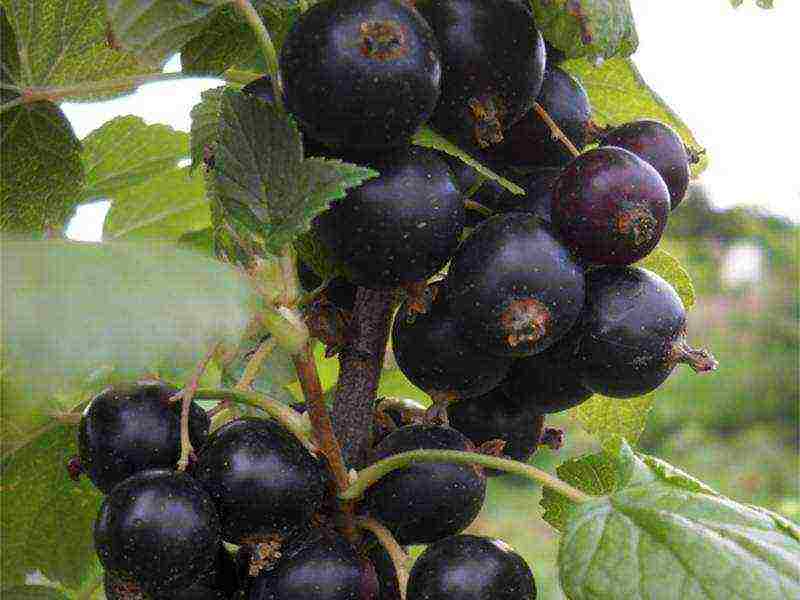
Berry up to 4 g, sweet. The height of the bush is up to 1.5 m.
Advantages: resistant to frost, heat, powdery mildew.
Exotic
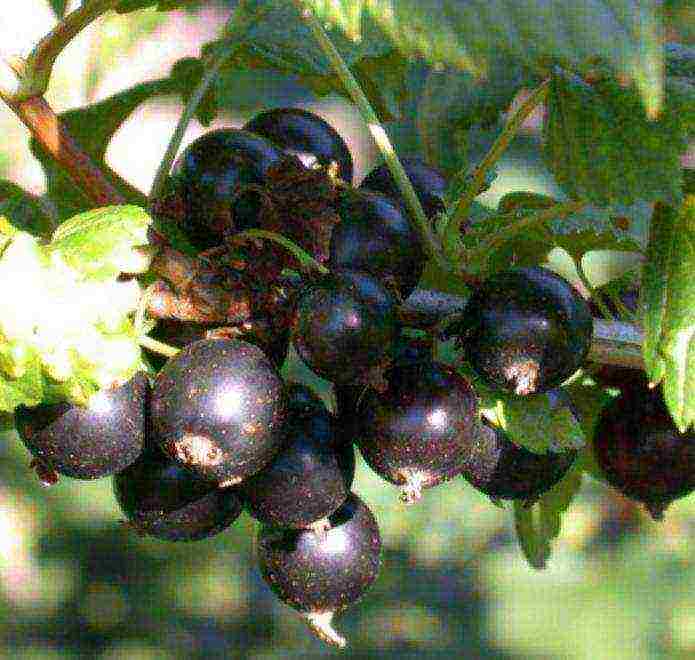
Berries up to 3 g with a sweet and sour taste. They grow on medium-sized bushes with a yield of 1.5-2 kg per year.
Advantages: bushes are not prone to thickening.
Advantages: resistance to the appearance of powdery mildew, resistance to winter cold. The keeping quality of the berries after picking.
Disadvantages: relatively low yield - up to 1 kg per bush.
Perun
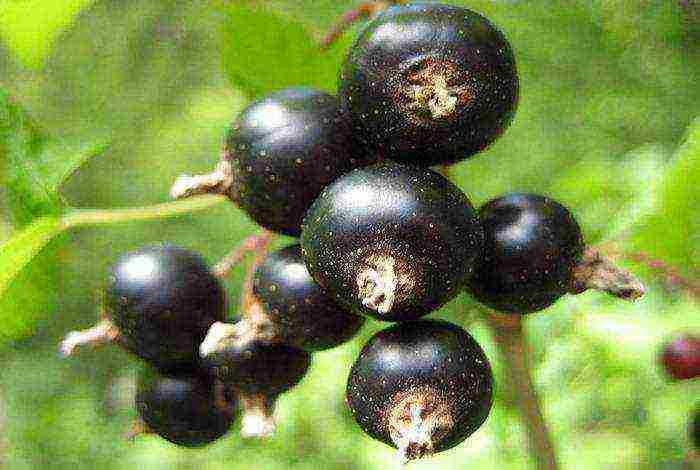
Berries weight up to 2 g. Collected in a brush of 10-14 berries. Harvest from a bush - up to 2 kg. The taste is sweet with a slight sourness, 9.5% sugars, and a very strong aroma.
Advantages: resistance to winter and return frosts, to heat.
Disadvantage: it suffers greatly from powdery mildew, requires a garter of branches on a trellis.
Medium black currant varieties
Medium varieties ripen in late June and early July. Medium late - the second decade of July. They are popular due to the content of a large amount of nutrients. Among the representatives of mid-season varieties - the bestsellers Yadrenaya, Dobrynya, Izyumnaya.
Here are a few mid-season varieties.
Dubrovskaya
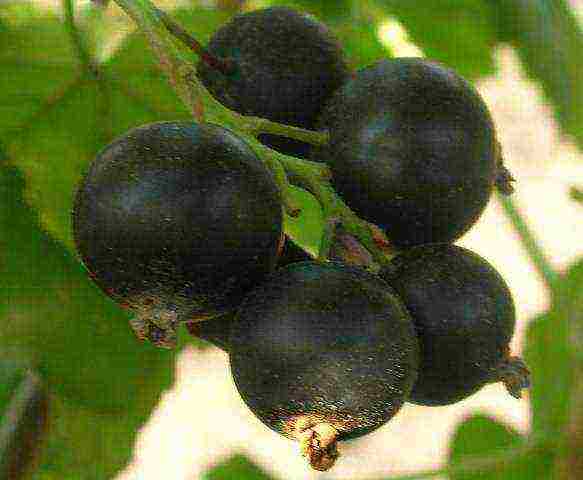
A variety that combines a high yield per bush (up to 3 kg) and its small compact size. Therefore, it is ideal for small summer cottages. The weight of the berry on the bush reaches 2.5 g, the taste of the berries is sweet and sour (they contain 7% sugars).
Advantages: resistant to cold weather, mites and terry.
Disadvantages: the bushes are prone to thickening, often affected by powdery mildew.
Crane
Berries of medium size (up to 1.5 g each), quite sweet in taste (contain up to 10.5% sugars). Sprawling bushes, yield up to 4 kg per year.
Advantages: the berry is dense, transportable, suitable for mechanized harvesting.
Venus
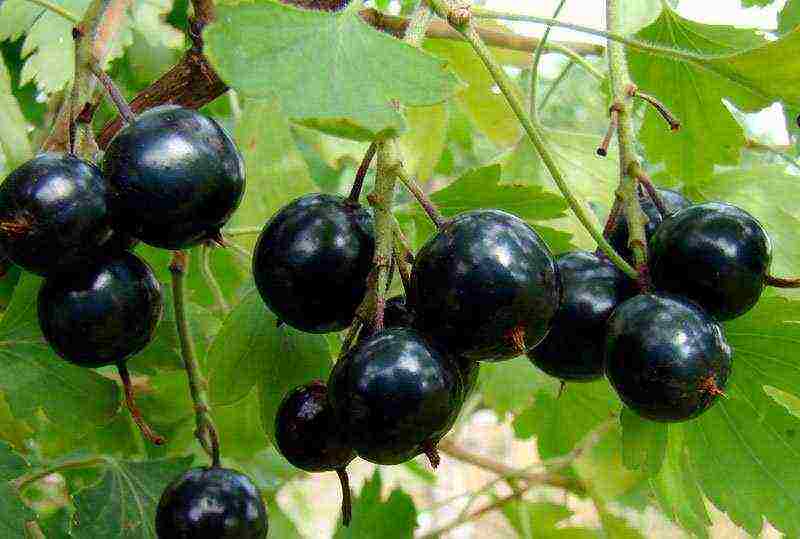
Berries up to 6 g, in a brush up to 10 berries, contain about 7% sugars - sweet and sour taste. Collect up to 5 kg from the bush. Good winter hardiness and drought resistance. Grows well and bears fruit in partial shade.
Advantages of the variety: begins to bear fruit early and extends the fruiting time to August.
Disadvantage: low resistance to mites, septoria and hazel grouse. Poor transport stability.
Late varieties of black currant
Ripen in early August. Often they are affected by fungi, pests due to prolonged aging.Therefore, for late varieties, resistance to diseases, pests, resistance to heat, and lack of water in the soil are important.
For a long time of ripening, throughout the season, the bushes are exposed to various "misfortunes". They must successfully survive the lack of moisture, release new pagons and grow a consistently high berry yield.
Also important: for a long ripening, the berries need a dense peel. It shouldn't crack. Such berries are excellent for transportation, they are not damaged during mechanized picking. It is also convenient to freeze them. Here are the characteristics of popular late-ripening varieties.
Bummer - late-ripening variety
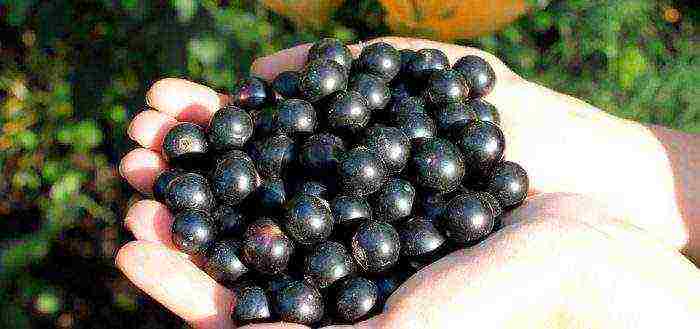
Berries up to 3 g, sweet (more than 9% sugar), collected in medium-sized clusters, 8-10 berries each. The yield indicator is average - 2.2 kg of ripe berries from a currant bush per season. The bushes themselves are tall, dense, medium spreading.
Features of agricultural technology - suitable for mechanized assembly.
Advantages: frost resistance and resistance to pests, fungal diseases, except for dew.
Disadvantages: instability to powdery mildew, gradual ripening, unstable yield.
Arcadia
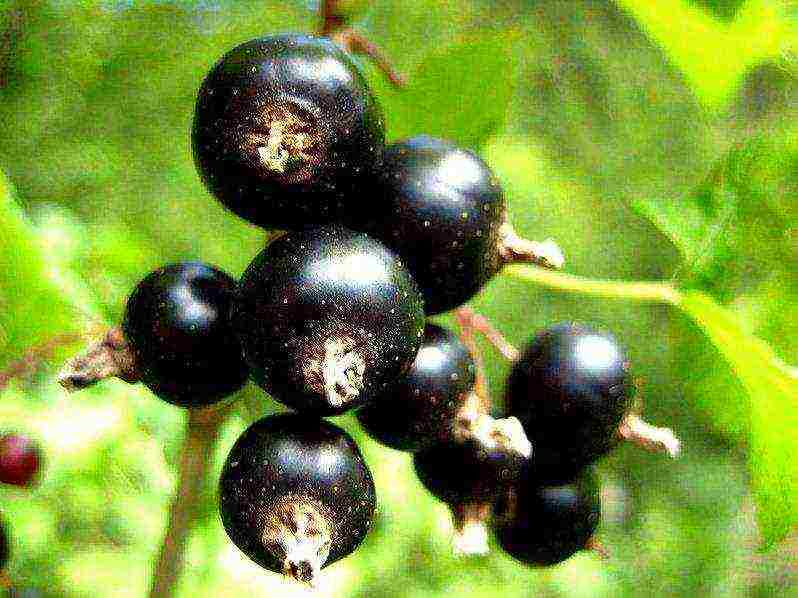
A variety with rather large sweet and sour berries, the weight of which reaches 5 g. The yield per bush is average and is 2.5 kg. The bush is 1-1.2 m with curved branches.
The variety has a disadvantage, traditional for low bushes: under the weight of the harvest, the branches fall to the ground.
Vologda
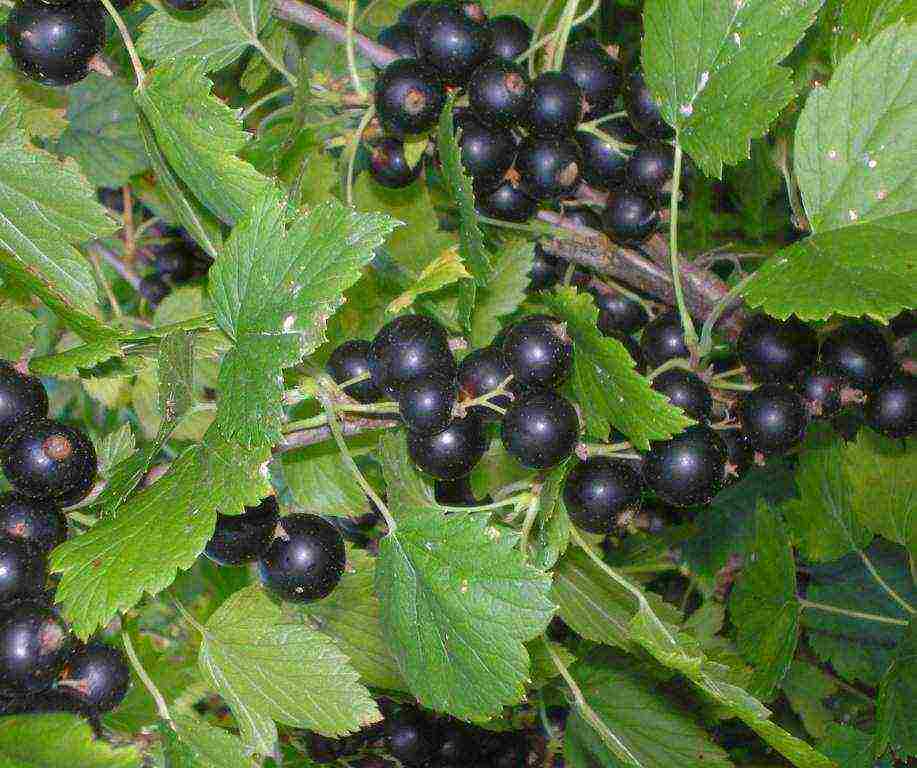
Yield leader among late varieties. Yields 5 kg of berries from a bush, weighing more than 2.2 g. Berries grow in clusters of 40 for easy harvesting. Sprawling bush, withstands cold up to -35 and heat up to +45.
Disadvantage: Prone to rust, uneven maturation, requires garter.
Altai Late
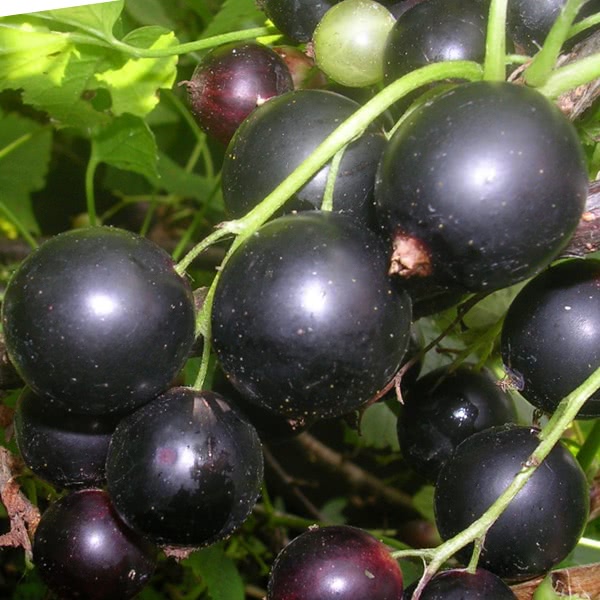
Produces berries of medium size - up to 1.2 g in weight, collected in 10-14 pieces per cluster. The sweetness of the taste is provided by 8% sugars.
The variety is resistant to various fungi and pests, except for powdery mildew.
Tatyana's Day
Sufficiently sweet (9.5% sugar) and medium-sized (up to 1.5 g) berries. Up to 3 kg of harvest ripens on the bush. Suitable for mechanized assembly.
Disadvantage: not resistant to spider mites and powdery mildew.
This variety of currant is presented in the form of 150 officially registered varieties, hybrids - over 100. In order to understand the classification, it is customary to divide by ripening time, yield, size of berries, method of pollination and resistance to diseases. To begin with, we will give the best varieties of black currant for central Russia, and then we will tell you about the varieties in separate categories.
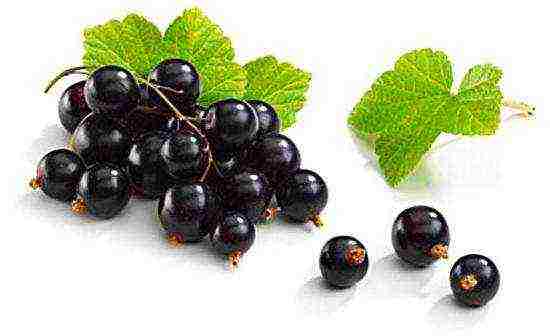
The best varieties of black currant for central Russia
Among all the diversity, it is difficult to determine the really best varieties; every gardener needs to focus, first of all, on the climate of the region, secondly, on cold resistance and, thirdly, on personal taste preferences. Immediately, we note that there is no fundamental difference in taste and concentration of nutrients. All varieties are equally useful, they are consumed fresh and canned, this is an excellent prophylactic agent against colds and spring beriberi. The only thing that distinguishes one variety from another is the concentration of sugar (glucose). The more it is, the sweeter the berries will be.
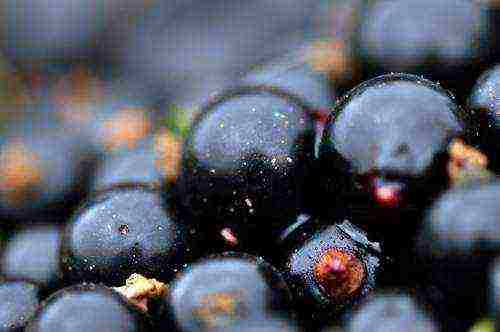
The concentration of vitamin C is higher than in lemons and kiwi
When choosing the best varieties of black currant for the Moscow region, it should be borne in mind that only 50 of them are the most suitable for growing in such a climate. The priority is given to resistance to frost and prolonged cold snaps, endurance in relation to pests and diseases.
Fragrant
A variety that gives early fruits, you can taste the first berries already in mid-June. There is a sour aftertaste, the pulp is elastic. Fruits are small - up to 2 gr., From one bush you can collect up to 4 kg of berries. There are few shoots, they do not require a garter during the fruiting period.There is a high resistance to disease. Sometimes aphids attack.
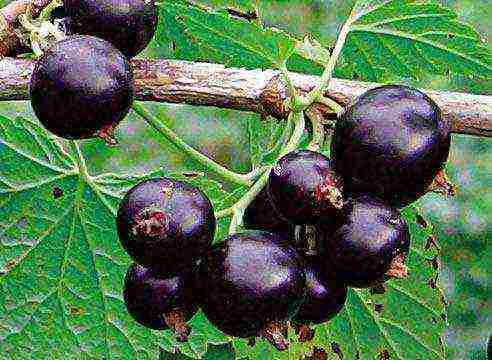
Fragrant
Selechenskaya
Ripens in the third decade of June; in mid-July, all the berries reach removable maturity. Large-fruited - up to 5 gr., From one bush gives about 6-7 kg. Erect. No garter required. Medium height. The appearance of powdery mildew is extremely rare, only in those cases when an epidemic literally begins. Sometimes green mottles appear.
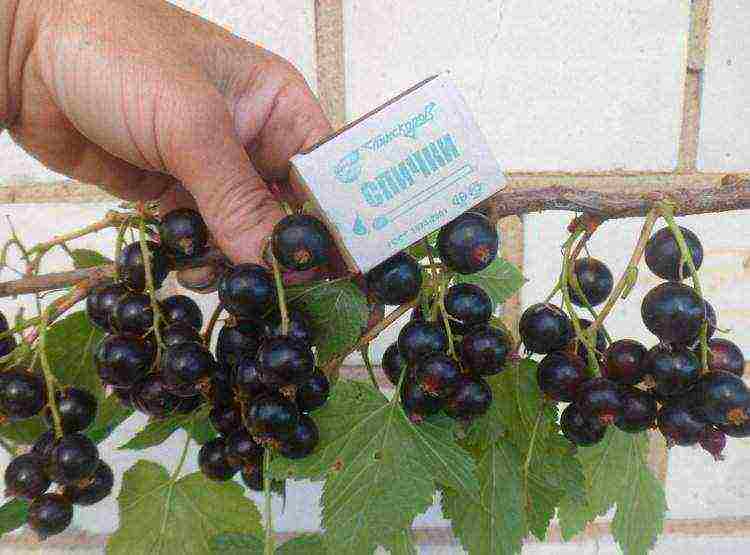
Selechenskaya
Read in this article: Tobacco mosaic virus on plants
Openwork
It belongs to the category of the best varieties of currants due to its taste - very sweet, sometimes even cloying. Great for fresh consumption, juicing and preservation. The berries are small - weighing up to 2 grams, the bushes give an average yield - within 3 kg. A frost-resistant variety, rarely damaged by pests and diseases.
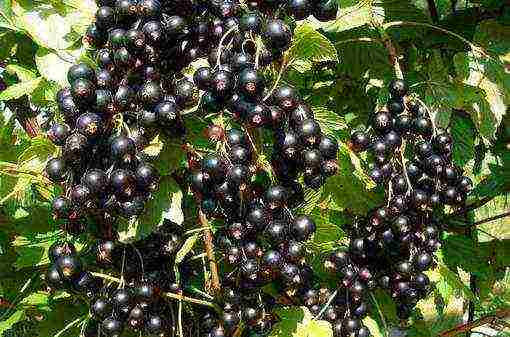
Openwork
The best varieties of early ripening black currants
It is noteworthy that when choosing the best varieties of currants for the middle lane, the gardener is interested in two positions - as early and rich harvest as possible. This is due to the fact that most of the crop is immediately processed in the form of jam, marmalade, juices, etc. In the southern regions, on the contrary, preference is given to varieties that ripen closer to August, which can be stored for a certain time and consumed fresh.
Black BMW
Early ripening form with small but very sweet fruits. Their size with favorable care reaches 4 grams, from one bush you can collect up to 5 kg per season. Resistant to disease. It is able to withstand prolonged frosts.
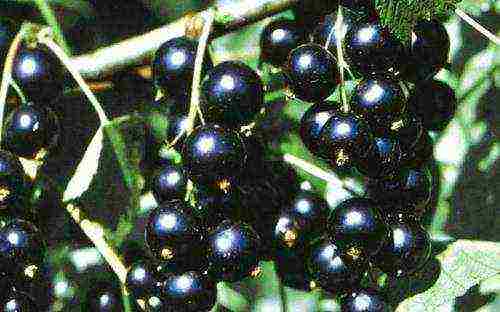
Black BMW
Temptation
A dessert variety that gives a very large yield. With good care, insulation for the winter, the use of organic matter and timely pruning of shoots from one bush, you can collect up to 6 kg of berries. At the same time, the fruits are very sweet with a high sugar concentration (up to 17%), which is great for fresh consumption and even for making wine.

Temptation
VIDEO: How to make homemade currant wine
Legend
One of the most productive early varieties with exceptionally sweet berries. The fruits themselves are not large, but in aggregate they give about 5-6 kg from one bush. There is a high resistance to subzero temperatures and diseases. Requires hilling and insulation for the winter. To do this, the root zone is covered with dry manure, covered with branches or last year's foliage, and the shoots themselves are wrapped in spunbond.
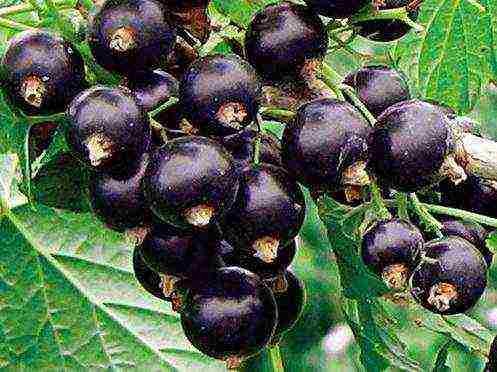
Legend
Gulliver
A productive medium-ripening variety - the berries can be picked at the end of July. The variety is very sweet, on a bunch there are up to 17 berries of the same size. By analogy with many varieties, there are good indicators of resistance to frost and disease. Requires mandatory shelter at the end of the fruiting period and before the onset of the first frost.
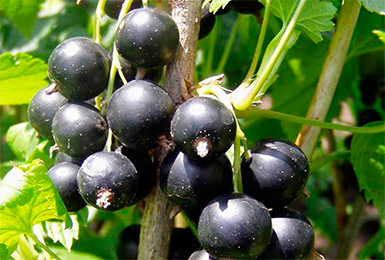
Gulliver
Cossack
One of the most unpretentious varieties, giving a large harvest in the middle of summer. With equal indicators with other varieties, it is absolutely undemanding to soil fertility and to the abundance of fertilizers. The mass of berries is up to 7 gr., The yield from one bush is up to 5 kg.
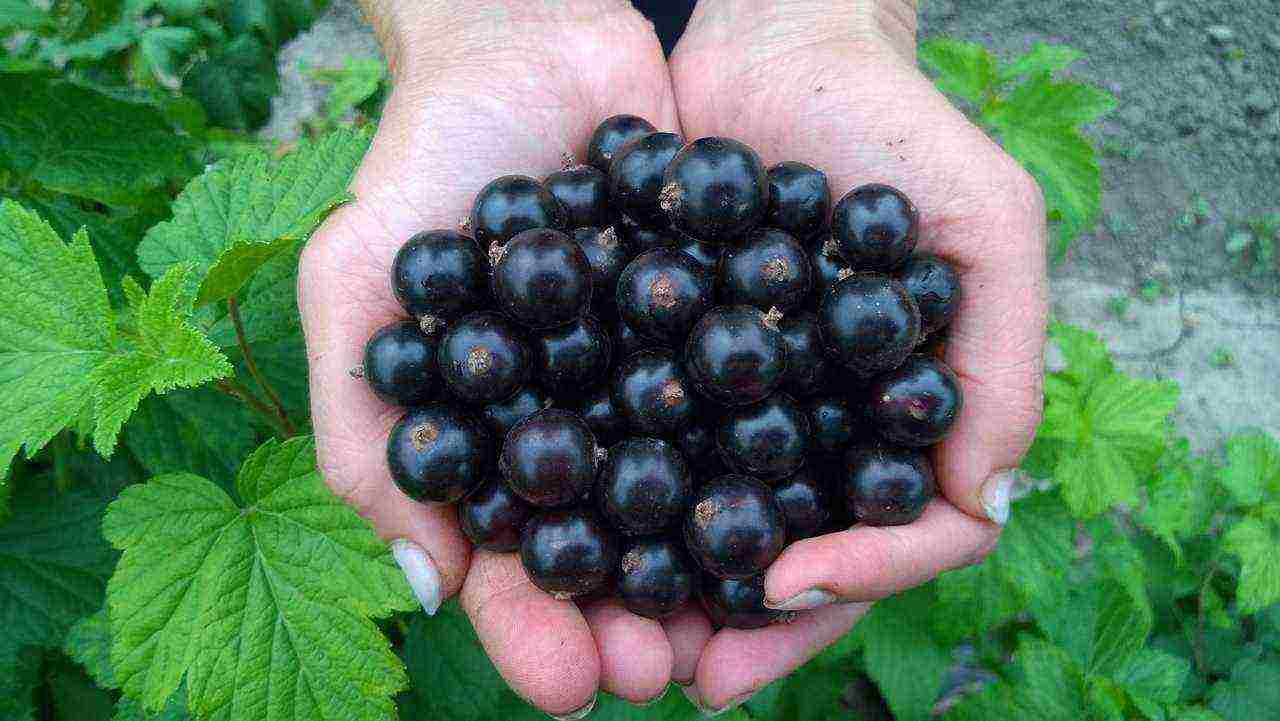
Cossack
Video: How to properly cut currant bushes
The best large-fruited varieties of black currant
The forms listed below are also considered the best varieties of black currant for the Moscow region, since they give large berries, the size of some is not inferior in size to a quail egg, and, accordingly, a large harvest.
Vigorous
Culture with the largest berry among all known varieties and hybrids. The size of the berries varies from 2.5 to 3 cm, while all fruits are very tasty with a slight astringency. Shoots must be tied up, since during the period of removable ripening, the branches can break. On average, one bush gives up to 10 kg of harvest.
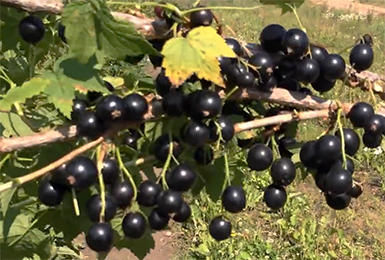
Vigorous
Ariadne
A form specially developed for regions with cold climates, resistant to precipitation and frost. Fruits are medium, yield up to 7 kg per bush. Shoots should be tied up before they are fully ripe. Berries can be eaten fresh or preserved. Judging by the reviews of gardeners, it takes root well and bears fruit well even in the Urals.
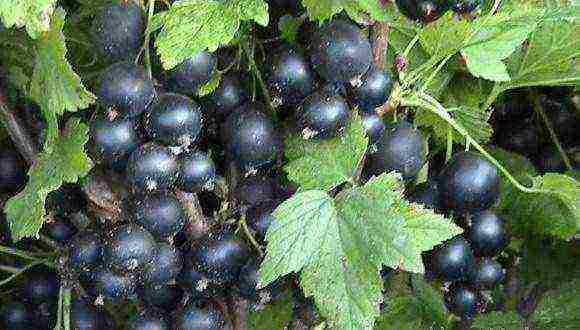
Ariadne
Belarusian sweet
Initially, this form was cultivated and designated in the category of the best varieties of black currant for black soil, but later it began to be actively cultivated in the non-black earth zone of some regions of our country. In particular, we are talking about Siberia, the Urals, the Moscow region and the Leningrad region. The berries are medium, sweet, used in industrial whole for the preparation of juices, in household ones - only for consumption, since they are completely unsuitable for long-term fresh storage.
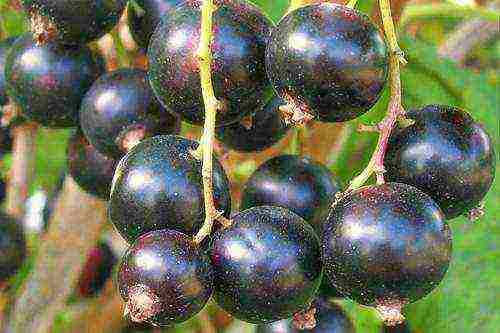
Belarusian sweet
Dobrynya
A variety with very large sweet berries, giving a solid - up to 7 kg - yield. Grows in all regions. The ripening period varies depending on the climate. It does not crumble as it ripens, it can be easily removed from the stalk.
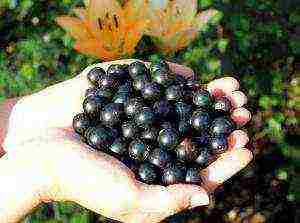
Dobrynya
The sweetest varieties of black currant
Depending on the color of the berries, black, red and white currants are distinguished. The sweetest of these is black, the taste of which is determined by the sugar content. If in a berry it exceeds the threshold of 10%, such a variety is considered dessert and is suitable for fresh consumption and the preparation of various preserves.
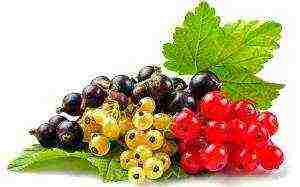
Among these varieties, the following are worth noting.
An excellent pupil
The sugar content exceeds 11%, which puts it in the dessert category. The variety is of medium ripening period, the harvest can be taken in mid-July. One bush gives on average up to 5 kg, berry weight - 3-3.5 grams.
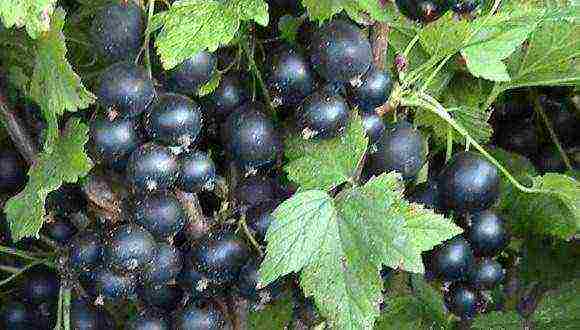
An excellent pupil
Bagheera
Sugar content 10.8%. Medium ripening. The berries are very sweet, aromatic and juicy. The yield is high - 5-5.5 kg. High frost resistance is noted. Not susceptible to disease.

Bagheera
Triton
The sugar content exceeds 10.5%. Gives a consistently large harvest annually. Grown in the middle lane, it feels great in cold regions. In the south, it gives record harvests in terms of volume.

Triton
Green haze
The sugar content is over 10%. A crop specially bred by breeders for those regions of Russia where there are less than 150 sunny days, and the average temperature does not exceed 250C.
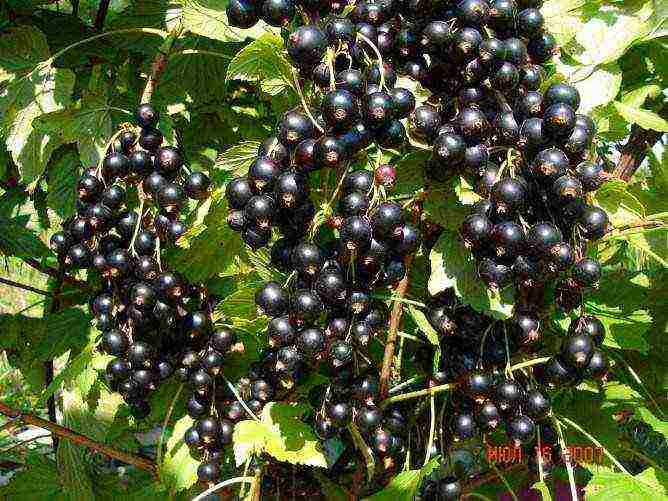
Green haze
Again, there are a lot of currant varieties, and choosing the best one is quite difficult. If we are talking about a personal plot, you can plant different varieties in order to get a good harvest of sweet and juicy berries. But at the same time, keep in mind that everything, even hybrid varieties, do not bear fruit for more than 10 years. Gradually, the berries become smaller, and after that they stop appearing altogether. Update the assortment in a timely manner and plant new bushes.
VIDEO: Tips for growing black currant
Throughout Russia, black currant grows near every house. Undemanding to the composition of the soil, accustomed to harsh winters, it yields even in the subarctic zone... This garden culture bears fruit even in Yakutia and the Khibiny, reached Sakhalin in the east and Krasnodar Territory in the south.
She inherited such a universal adaptation to the whims of the weather from a wild ancestor - the forest currant. There are a lot of varieties and varieties, so it is very difficult for a novice gardener (and not only) to make a choice.
Choosing varieties for central Russia
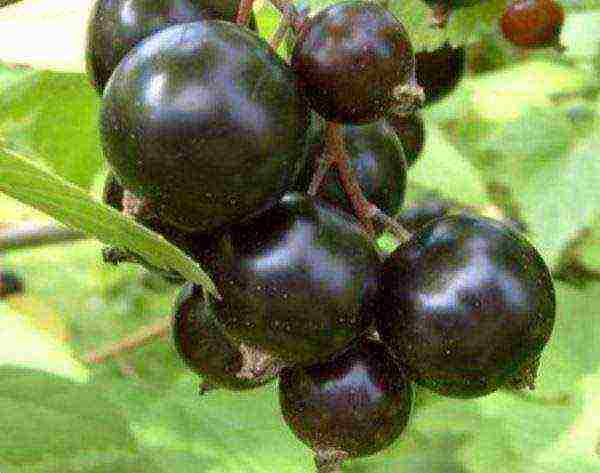 Early variety of black currant Exotic
Early variety of black currant Exotic
What are the differences between the varieties:
- By appointment,
- Ripening terms,
- The size of the berries,
- Productivity,
- The taste of berries
- Resistance to diseases and pests,
- Winter hardiness ...
It is very easy to understand the purpose of the variety:
- berries are tasty on their own - this is a dessert variety,
- thin-skinned, but too sour - boil jam or grind with sugar;
- berries with a dense strong skin are frozen,
- universal (understandable).
In order not to be mistaken, it is necessary to choose only zoned varieties.... Only on such bushes can you get a high yield stably and without much effort.
Ripening terms, size of berries, their taste may differ not only from the region of cultivation, but even from watering or soil composition. Already at a distance of more than 200 kilometers, the characteristics of the variety can change significantly.
If you live in the middle lane, you should take a closer look at these varieties:
| Curiosity, Selechinskaya, Exotic, Openwork, Summer resident, Orlovia, Exotic |
| Black pearl, Loyalty, Perun, Green haze, Zusha |
| Kipiana, Vigorous, Venus, Mermaid |
Among the fruit-bearing ones, the Selechinskaya, because he combined the best qualities of his ancestors - wild currant and gooseberry.
Most varieties have an Achilles heel - they cannot grow without abundant watering. But Selechenskaya calmly copes with both summer drought and frosty winters, which makes its choice suitable for any region of Russia.
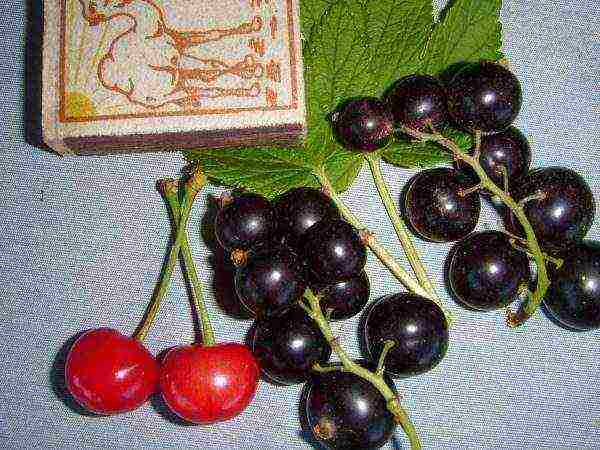 An early variety of black currant Selechenskaya
An early variety of black currant Selechenskaya
To all this, also add five kilograms from a bush of large berries the size of a cherry... There are no special advantages in varieties intermediate between early and late ones. They give fewer berries, and this is not because the varieties are not good enough.
It's just that the period of their fruiting falls on the period of summer heat and dry wind.
The main purpose of these varieties is to fill a niche in front of the later, most productive varieties.
Ripening of late varieties of berries lasts from late July to. the end of autumn. Wherein the Kipiana variety has a yield of up to 5 kg and is resistant to powdery mildew and is not afraid of kidney mites.
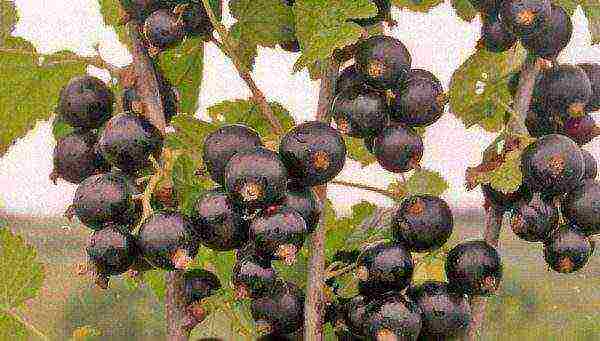 Late black currant Kipiana
Late black currant Kipiana
Vibrant yields late, but these berries can compete even with grapes in size - even 8 grams... There is a known case when an experienced gardener had a berry reached the size of a metal ruble!
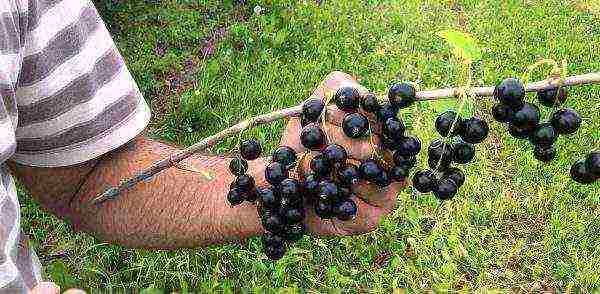 Late variety of black currant Yadrenaya
Late variety of black currant Yadrenaya
The Viper bush usually yields almost 4 kilograms of berries.... The popularity of the variety is also due to its resistance to pests and fungal diseases.
Currant for Siberia
Siberia is known not only for its harsh winters, but also for its hot dry summers. These stressful weather conditions are easily tolerated by the zoned Siberian varieties:
| Lama, Nika, Gift to Kuzior |
| Altayanka, Agata, Galinka, Rita, Spherical, Fun, Prestige, Ksyusha |
| Mila, Harmony |
New varieties successfully withstand not only frost, but also arid heat. They are able to withstand major fungal diseases and insect pests.
In terms of early maturity, the specified varieties also set records: the first harvest from the currant bush of the new Nika variety reaches 1.2 kilograms.
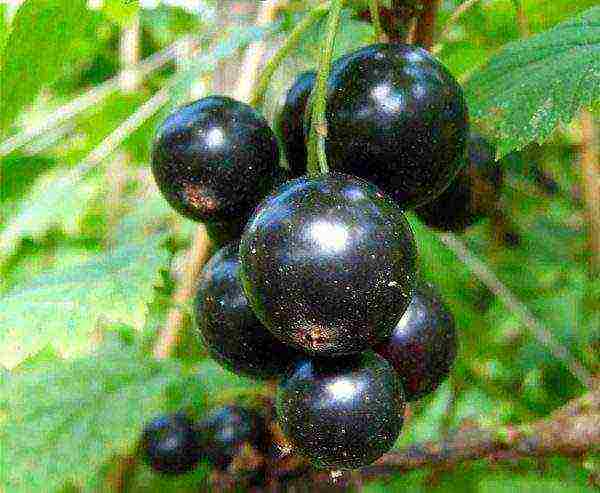 Nick's early blackcurrant variety
Nick's early blackcurrant variety
Berries of Siberian currant Large-fruited Litvinova even reach 6 grams!
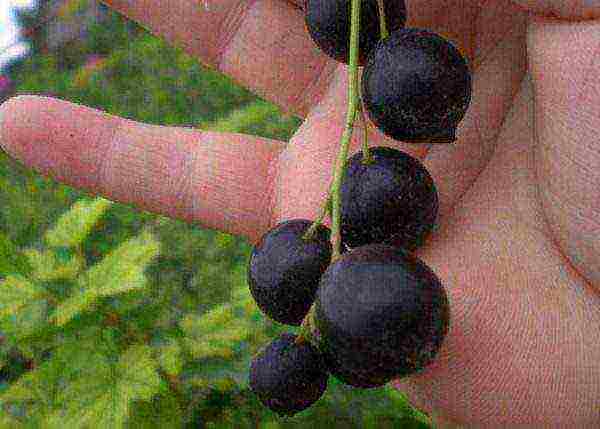 Black currant Large-fruited Litvinova
Black currant Large-fruited Litvinova
What are the largest-fruited varieties?
Undoubtedly, varieties of unusually large berries will become the leaders of the list.
| Vigorous | medium late variety for universal use berries from 3 to 8 grams non-uniform, yield 3-6 kilograms per bush, non-uniform fruits, aging quickly |
| Dobrynya | universal purpose, bears fruit in the second half of July, berries up to 7 grams are also non-uniform, almost five kilograms can be removed from the bush |
| Selechenskaya-2 | universal variety, bears fruit in early July. Berry picking - up to 5 kilograms per bush |
The best large-fruited varieties: Vigorous, Selechenskaya, Globus, Pygmy.
When choosing a super-large-fruited variety, one should not forget that usually such plants require additional feeding and watering, especially in dry summers and if they are planted on sandy soils.
The most resistant varieties
They practically do not get sick, which means - the harvest is ecologically cleanest among the varieties:
- drought tolerant - Dobrynya, Gulliver, Izumnaya;
- disease resistant - Sibylla, Gross, Gamma, Gulliver, Sevchanka, Globus, Muravushka;
- frost-resistant - Sibylla, Venus, Romance, Globe, Pearl, Rhapsody, Vigorous;
- pest resistant - Orlovia, Kipiana, Grazia, Gamma.
Gourmets also have plenty to choose from
If the score is higher than 4.5 points, the variety is assigned to the dessert category: Centaur, Perun, Selechenskaya, Selechenskaya-2, Nadia, Venus, Oryol waltz, Slastena, Beaumond, Nestor Kozin, Tisel, Uralskaya sweet, Raisin, Black eye.
The Iziumnaya variety has an interesting feature: after ripening, the berries do not crumble from the stalk, but gradually “rave”, hence the name of the variety.
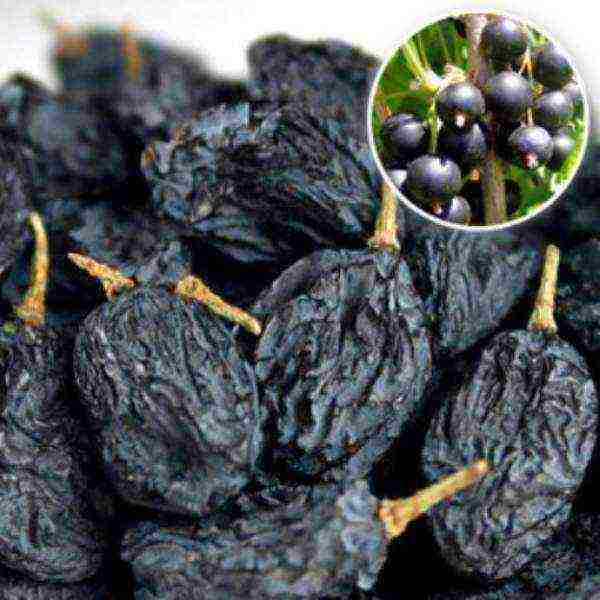 Black currant Raisin
Black currant Raisin
The best of the early varieties - Pearl, Black Boomer, Raisin, Legend.
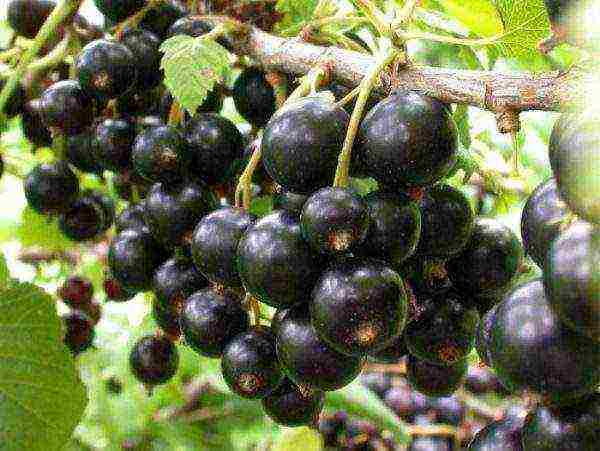 Currant Black Boomer
Currant Black Boomer
Lazy person - late variety with very large berries up to 6 grams.
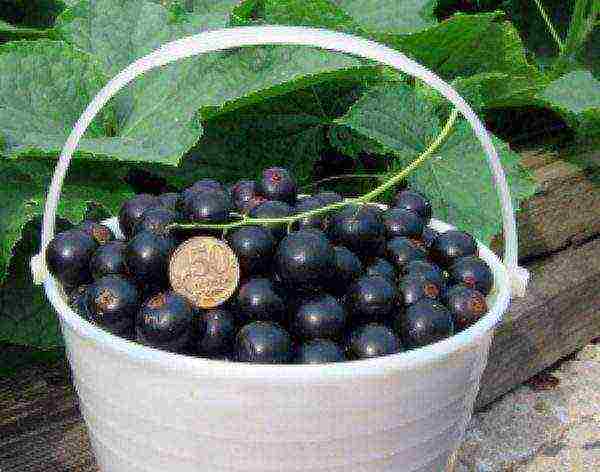 Blackcurrant Lazy
Blackcurrant Lazy
What's new for residents of the Moscow region?
The weather in the Moscow region is characterized by relatively mild winters and rather warm, humid summers. This is the climate that black currants like. However, the soil composition differs even in the districts of the Moscow region.
It is necessary to select varieties not according to yield or taste, but exclusively, adapted to the specifics of the soil composition of the region.
The most famous varieties among summer residents: Veloy, Memory Lisavenko, Sudarushka, Dobrynya, Yadrenaya.
To feast on berries all season, you must choose from the following varieties:
| Sevchanka, Nara, Moscow black, Dar Smolyaninova, Golubichka, Selechenskaya, Selechenskaya-2 |
| Dobrynya, Green haze, Darkie, Oryol serenade, Daughter, Izmailovskaya, Paulinka, Perun |
| Vologda, Lazy, Veloy |
It should be noted that late varieties for the Moscow region are far from the best choice. Summer residents simply may not have time to take advantage of all the best qualities of the same, for example, Lazy - the berries may not ripen.
The Yadrenaya variety, as already noted, was highly appreciated by summer residents for many literally unique qualities:
- high yield,
- very large plum berries,
- compact bush,
- self-fertility,
- winter hardiness,
- early maturity.
Even if you are overwhelmed by the size and flavor of the berries, there are still some characteristics you need to figure out.
What characteristics should you pay attention to first of all:
- self-fertility (no additional pollinator is needed),
- susceptibility to diseases and pests,
- resistance to spring frosts and other weather factors.
If you plant several varieties nearby (even self-fertile ones), there will be much more berries.
Therefore, stress-resistant Gulliver will not create problems with weather whims, and Smolyaninova's gift will delight you with an early harvest even without chemical treatments for pests and diseases.
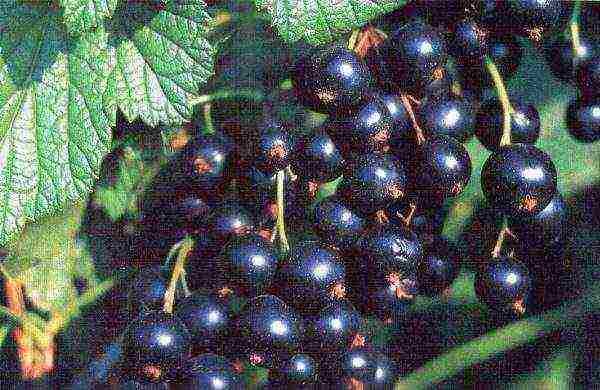 Black currant gulliver
Black currant gulliver
Another gift for fans of ecological products - variety Orlovskaya serenada, which is practically not afraid of kidney mites , and from fungal diseases - powdery mildew.
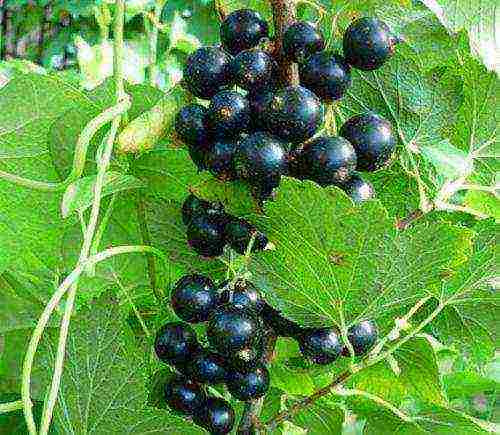 Black currant Oryol serenade
Black currant Oryol serenade
Variety Selechenskaya-2 with its increased ecological plasticity, will not be afraid of lack of water and unsuitable soils... As a result, the summer resident will receive from the bush his prescribed 5 kilograms of berries the size of a cherry.
Conclusion
It is very difficult to choose the right variety of black currant bush., but the correct solution to this problem for an ordinary summer resident exists. This is to acquire zoned modern varieties of different ripening periods. Their high yield, unpretentiousness, harmonious taste has already found confirmation in personal plots throughout the country.
